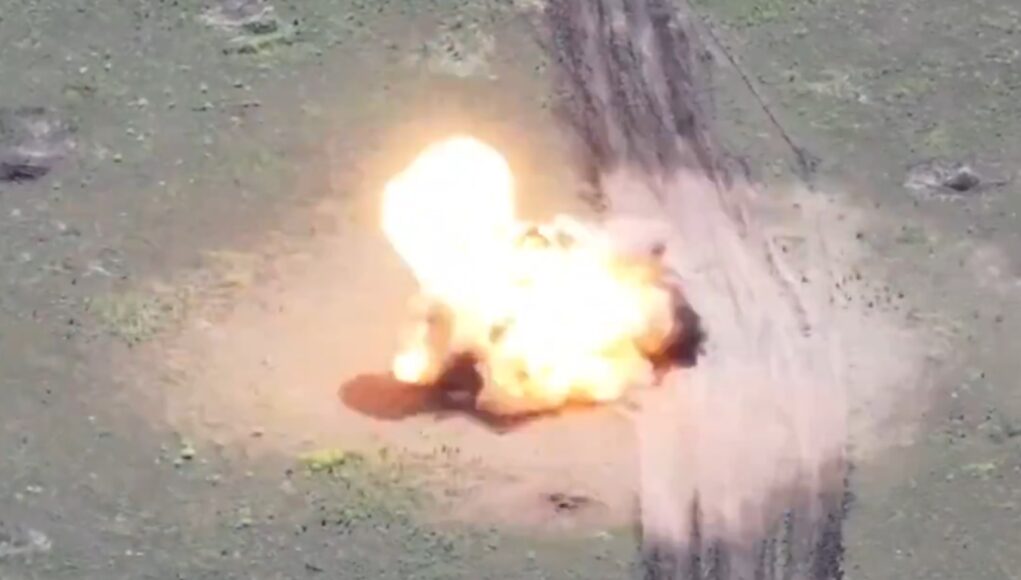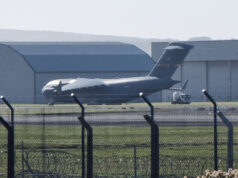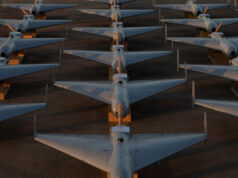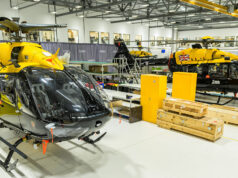The UK must urgently adapt to a transformed battlefield shaped by mass drone warfare or risk being unprepared for the conflicts of today, not tomorrow — that’s the stark warning issued by Alistair Carns MP, Labour’s Minister for Veterans and People at the Ministry of Defence and a decorated former Royal Marines officer.
In an extended thread posted to X, Carns delivered a powerful assessment of the new nature of war, drawing directly on operational realities observed in Ukraine and lessons applicable across all theatres of potential future conflict.
“The character of conflict has changed,” Carns began. “For the first time since WWI a weapon system other than artillery (offensive support) has resulted in more casualties—drones!”
“For the first time a Navy without a Navy has defeated a Navy—with drones.”
“Most deep strikes are being executed with drones… dumb hardware equipped with increasingly sophisticated software.”
These insights, drawn from the ongoing war in Ukraine, underpin what Carns views as a critical turning point in military thinking — one he believes Britain must urgently internalise.
The character of conflict has changed:
1. For the first time since WWI a weapon system other than artillery (offensive support) has resulted in more casualties——drones!
2. For the first time a Navy without a Navy has defeated a Navy ——with drones.
3. Most deep strikes are being… pic.twitter.com/X118lKjU9I— Al Carns (@AlistairCarns) April 20, 2025
‘We Must Rethink Everything’
“We need an equitable mix of mass-produced drones coupled with high-end sophisticated weapons systems across all domains,” Carns insisted.
“We need an industrial base that can scale and sustain the demand and scale of modern warfare.”
“We need to change our tactics, techniques and procedures to include the use of mass drones.”
“If we are not training our men and women on drones… it would be similar to not training our men and women on artillery prior to WWI = unthinkable.”
Carns rejected a number of what he called “common misperceptions” in current strategic discourse:
“Lessons from Ukraine are not applicable to other theatres.”
“We need to be careful of pretending we will have the option to fight differently… our adversaries will use attrition to be decisive.”
He argued that the idea of a binary choice between sophisticated and unsophisticated systems is outdated:
“A combination of the two is key to success. Mass-produced systems complement and increase the longevity and effectiveness of high-end capability.”
New Battlespace
Carns painted a vivid picture of future — and in many ways, present — battlefields:
“On a division frontage at any one time there will be hundreds of surveillance drones watching every sector of the battlefield.”
“These will be backed up by teams of operators using attack drones… queued on to target, resistant to electronic warfare or fibre optic controlled.”
“They will launch, hunt and strike targets. Thousands of drones a day. First Person View, dropper drones and bombers operating tens of kilometres away from the front line, every hour of every day of the year.”
He went on to describe maritime and aerial drone dominance:
“In the Maritime: Patrols of Unmanned Surface Vessels control the Black Sea… armed with standoff systems, they can operate for days at a time at thousands of nautical miles, identifying, queuing and striking surface targets with ease.”
“In the Air: Hundreds of long-range jet or propeller driven drones can now fly in formation, overwhelm (or strike) sophisticated enemy air defence systems and defeat targets in depth.”
No Longer Theory
“Imagine technology equipped with sophisticated data terrain mapping systems, target identification software and artificial intelligence,” Carns said.
“Allowing uncrewed systems to travel to their operating area, identify, select, hunt and strike targets either autonomously or with the requirement for a human in the loop.”
“This technology is available now.”
Carns’ future vision is one of sheer scale:
“Imagine this not with ten or twelve drones but hundreds and thousands across all domains… resistant to electronic warfare, or controlled through fibre optics and equipped with stand-off systems.”
“Systems thinking for themselves within parameters.”
And he sees it extending beyond the battlefield:
“In scenarios other than war… imagine costly counter terrorism strikes replaced by simplistic but lethal drones… intelligence collection or shadowing ships conducted by multiple unmanned surface vessels… costly helicopter resupply being replaced by heavy lift drones.”
Some more thoughts on the character of conflict….
On the Land. On a division frontage at any one time there will be hundreds of surveillance drones watching every sector of the battlefield. These will be backed up by teams of operators using attack drones. Queued on to target,… pic.twitter.com/mOgsIRO8yg
— Al Carns (@AlistairCarns) April 21, 2025
Morality, Strategy, and Urgency
Carns acknowledged the serious implications of this shift:
“There are serious implications for this way of warfare but we must embrace it.”
“Whether we like it or not, this is the new way of warfare, and we have an obligation not only to lead in this space… but to help define and implement the guardrails for its future use.”
He provocatively suggested a change in focus for armed forces:
“If I were to be provocative, the future of conflict may not only be about equipping the soldier, the sailor or the airman to fight more effectively — but equipping and enabling the technology to fight for you.”
Carns’ call for doctrinal overhaul carries the weight of both operational experience and ministerial responsibility. A former colonel in the Royal Marines, recipient of the Military Cross, and ex-adviser to three Defence Secretaries, he now serves in a government role focused on people — but his remarks show a willingness to engage deeply in strategy and doctrine.
His post concludes with a blunt reminder:
“The future of warfare is changing. It has already changed… the future is now.”














If EW is no longer an option in many cases, then kinetic solutions are the only way forward (something I have long considered the best option once you get past the “store bought drones”). So far the best solutions at the lower end has been the RWS suppliers with either guns or lasers (or both). It’s been the MoD’s & top brass of the world that are dragging their feet with their idea that it will go away or it’s not that important. They are similar to those that thought bayonet charges across open terrain in front of machine guns would work.
To a certain extent I agree.
There has to be a massive shift to anti drone measures to keep the battlefield fightable.
In a lot of cases with low end drones some pretty simple well aimed rounds would suffice. So 40mm optimised for anti drone would seem to me essential. With perhaps a smaller calibre for the FPV drones deemed of lower threat to prevent ammunition attrition becoming the driver.
EW is going to be a thing and it will work. But the other side will also put its drone parts in glorified microwave ovens and see what fails and then fix that so it requires more power.
There remains a mentality in UK defence circles that it is somehow necessary to put your own people in harm’s way in order to command any moral authority (rather than automating the whole business). I don’t see the logic myself- a successful military force is one that can permits you to kill or incapacitate the enemy while keeping your own people out of harm’s way, or as Patton put it: “No b****** ever won a war by dying for his country. He won it by making the other poor dumb b****** die for his country”.
Yet it’s been 3 years and little has been done to acknowledge the change in warfare
Plenty of speeches though….
Oh here we have another one!
We want to know whats the plan?
Are they going to restructure Brigades to allow for a Drone Company etc… and for its equipment and logistics
Every fundraiser I’m involved with from the frontline in Ukraine is drone-dominated . It never stops!
Statistics via Ukrainians –
75% (-/+) of all RuAF Casualties are from drones
20% (-/+) are from Artillery
4% (-/+) are from small arms
I do wonder what the difference would have been if Ukraine had a modern Airforce to begin with? It is now starting to catch up, but will never match Russia on a 1 vs 1 basis.
There is one aspect that has not been touched on, which are the legal obligations of using drones, but with humans in the loop to make the kill decision. In the “West” I can see we will continue with the legal route of obeying the law, where there must be a human in the loop. But I can see quite plainly, that a lot of Countries will ignore this law and give drones full autonomy.
There is definitely a book in the making: Ukraine, a drone war.
For me the bit that is really Important is
1) doctrine
2) training
Essentially it really does not matter how good the drones are or if they are really the ones you want… it does not matter…because drones are disposable items , they are a consumable..what matters is that you have lots of them available and embedded at all levels of formations so people are completely familiar with them and constantly practicing…I’ve said it a number of times there need to be drones that are considered in the same way as section support weapons.. sections should be completely familiar with their use and how to defend against them…you only get them if your issuing them out at section level.
The second bit is industrial capacity..drones are consumables..that change every year and are used and discarded, so you need to be constantly making them and have the capability to scale up production..
The way the army keeps its drones in special units as experimental bits of test kit..is not going to make for an army that knows how to fight on a battlefield where your combating drones every few hundred yards of battlefield.
Then the multi billion £ aircraft carriers are obsolete for the most part.